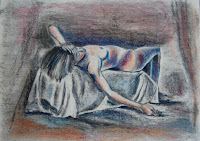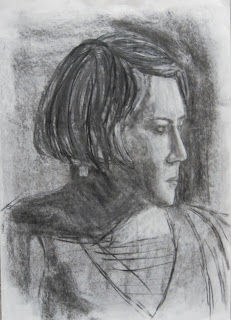Media: Charcoal and soft pastel on cream Ingres paper.
Reclining figure. First I covered the whole paper in charcoal, then sketched in the outlines of the figure. As I did so I continuously took comparative measurements with an extended arm and pencil. I also checked the shapes and angles formed by the figure’s contours and the negative spaces.
I did find during most of the process that the left hand was very troublesome to get the correct placement, direction and length from the wrist to the tops of the fingers.
Initially I enjoyed doing this drawing until I started adding pastel. When it comes to this medium I really haven’t much faith in my ability to bring things to a successful conclusion. I found that it took longer than I expected to layer the colours – most of which I did after the life drawing session.
At one point I was getting worried that things wouldn’t work but I persevered with very gentle layering – using complementary colours of blues and rusty oranges to give things a lift and to add strength to some of the charcoal shading. I darkened it a little with dark blue.
One difficulty was that the overhead lighting wasn’t very strong and I had to almost continuously half close my eyes to try and work out where the light was strongest.
Although it wasn't an intentional effect, looking at the finished drawing, to me the setting looks quite theatrical and I can see a subtle suggestion of stage curtains on either side of the figure.
I darkened many background areas bordering onto highlighted edges of the figure. I gently skimmed one colour over another, using shades of mostly rusty oranges where the planes are moving outward and mostly blues where the planes recede. On later inspection I realised the blue is a warm blue and appears to pull the background forward I think. Bread worked quite well as an eraser, soaking up pastel in areas where I built up the pastel too thickly.
 |
| Tonal Study |
Although I stood back to check the drawing several times during the process, just when I thought I was finished I noticed that the left wrist and hand looked so flat, it was as if they had been squashed in a mangle. The left elbow was too narrow, the right upper arm trailing downwards, was slightly too short and the right hand was too long. I was able to perform some rudimentary first aid on most areas by gentle erasing, with a putty rubber this time, and doing the necessary repair work, some of which entailed altering the angle of and making narrower, some fingers. Thinking the right hand would be trickier to rectify, I left it alone for fear of making it worse. A small advantage here is that the cast shadow at the end of the fingers possibly help this fault to appear less conspicuous than would otherwise be the case.
The lower leg was also too thick, as being further into the distance than the head it should have been narrower. I narrowed this later on, but now I think it looks a bit shapeless and straight.
I decided the brown colour in the background wasn’t working, it was moving into the foreground instead of receding as I wanted it to. So, throwing caution to the wind this time, I plunged in and rubbed it around on the paper with my finger. Luckily I don’t think it looks too bad now, in most places and even seems to soften the background, although not quite enough. However, because the rusty brown in the foreground pulls the foreground forward I find it too distracting. Perhaps the warm blue (as previously mentioned) would work better here. Pastel is always a medium I am very nervous about blending incase I spoil the effect completely - this has happened to me before. Soft pastel is a medium I think I really need some expert tuition with before I will start to see much of an improvement.
All in all I feel that I have overdone the blending on the tonal shading of the figure. Despite only using very light pressure, so as not to mix the colours on the paper and adding some short hatched marks in places, to vary the marks and add some texture, it didn't seem to make any significant improvement. On reflection it was a process I didn't enjoy and it wasn't surprising that on impulse I wrote 'I hate this drawing!' in my rough notes.
I blended the contours and features of many areas, including the head and left hand, in an effort to reduce their definition. I increased the amount of definition around the upper arm more than other areas, so as not to draw attention to too many areas at once, which would be confusing for the eye.This is one aspect, I think at least has worked to some extent.




































